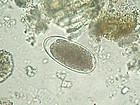Difference between revisions of "Trichostrongyloidea - Overview"
| (3 intermediate revisions by the same user not shown) | |||
| Line 1: | Line 1: | ||
| − | {{ | + | {{OpenPagesTop}} |
| − | |||
[[Image:Trichostrongylus.jpg|thumb|right|150px|''Trichostrongylus'' - Joaquim Castellà Veterinary Parasitology Universitat Autònoma de Barcelona]] | [[Image:Trichostrongylus.jpg|thumb|right|150px|''Trichostrongylus'' - Joaquim Castellà Veterinary Parasitology Universitat Autònoma de Barcelona]] | ||
| + | ==Introduction== | ||
| + | Trichostrongyloidea are a bursate [[Nematodes|nematodes]], with ''[[Dictyocaulus]]'' forming the only exception. Important genera include ''[[Ostertagia]]'', ''[[Haemonchus]]'' and ''Trichostrongylus.'' | ||
| − | The life cycle of | + | == General Life-Cycle == |
| + | The life cycle of Trichostrongyloidea is direct, and infection is through ingestion of L3. | ||
| − | |||
The egg is approximately 80µm long, oval, thin-shelled, and containing 4-16 cells, so is a typical strongyle egg. | The egg is approximately 80µm long, oval, thin-shelled, and containing 4-16 cells, so is a typical strongyle egg. | ||
| − | Egg → L1 → L2 → L3 occurs on the ground. | + | Egg → L1 → L2 → L3 occurs on the ground. L1 and L2 feed on bacteria, and L3 is exsheathed and represents the infective stage. L3 cannot feed, but do contain a finite amount of stored food to provide energy for movement. Infection is via ingestion of the L3. L3 → L4 → adult, these stages generally occur in the stomach or small intestine. |
| − | Parasitic development initially occurs in gastric glands or intestinal crypts, species dependent. | + | Parasitic development initially occurs in gastric glands or intestinal crypts, species dependent. Adults are generally found on the mucosal surface, and the prepatent period is typically about 3 weeks. |
| + | {{Learning | ||
| + | |literature search = [http://www.cabdirect.org/search.html?q=id:(%22Trichostrongyloidea%22)+AND+title:(%22life+cycle%22) Trichostrongyloidea life cycle publications] | ||
| + | }} | ||
| + | |||
| + | |||
| + | {{review}} | ||
| + | |||
| + | {{OpenPages}} | ||
[[Category:Trichostrongyloidea|A]] | [[Category:Trichostrongyloidea|A]] | ||
| − | + | ||
| − | [[Category: | + | [[Category:Expert Review]] |
Latest revision as of 13:05, 20 July 2012
Introduction
Trichostrongyloidea are a bursate nematodes, with Dictyocaulus forming the only exception. Important genera include Ostertagia, Haemonchus and Trichostrongylus.
General Life-Cycle
The life cycle of Trichostrongyloidea is direct, and infection is through ingestion of L3.
The egg is approximately 80µm long, oval, thin-shelled, and containing 4-16 cells, so is a typical strongyle egg.
Egg → L1 → L2 → L3 occurs on the ground. L1 and L2 feed on bacteria, and L3 is exsheathed and represents the infective stage. L3 cannot feed, but do contain a finite amount of stored food to provide energy for movement. Infection is via ingestion of the L3. L3 → L4 → adult, these stages generally occur in the stomach or small intestine.
Parasitic development initially occurs in gastric glands or intestinal crypts, species dependent. Adults are generally found on the mucosal surface, and the prepatent period is typically about 3 weeks.
| Trichostrongyloidea - Overview Learning Resources | |
|---|---|
 Search for recent publications via CAB Abstract (CABI log in required) |
Trichostrongyloidea life cycle publications |
| This article has been peer reviewed but is awaiting expert review. If you would like to help with this, please see more information about expert reviewing. |
Error in widget FBRecommend: unable to write file /var/www/wikivet.net/extensions/Widgets/compiled_templates/wrt693930174065f7_68893168 Error in widget google+: unable to write file /var/www/wikivet.net/extensions/Widgets/compiled_templates/wrt69393017462f16_51951099 Error in widget TwitterTweet: unable to write file /var/www/wikivet.net/extensions/Widgets/compiled_templates/wrt693930174a9395_22483980
|
| WikiVet® Introduction - Help WikiVet - Report a Problem |
